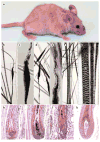Alopecia areata
- PMID: 28300084
- PMCID: PMC5573125
- DOI: 10.1038/nrdp.2017.11
Alopecia areata
Abstract
Alopecia areata is an autoimmune disorder characterized by transient, non-scarring hair loss and preservation of the hair follicle. Hair loss can take many forms ranging from loss in well-defined patches to diffuse or total hair loss, which can affect all hair-bearing sites. Patchy alopecia areata affecting the scalp is the most common type. Alopecia areata affects nearly 2% of the general population at some point during their lifetime. Skin biopsies of affected skin show a lymphocytic infiltrate in and around the bulb or the lower part of the hair follicle in the anagen (hair growth) phase. A breakdown of immune privilege of the hair follicle is thought to be an important driver of alopecia areata. Genetic studies in patients and mouse models have shown that alopecia areata is a complex, polygenic disease. Several genetic susceptibility loci were identified to be associated with signalling pathways that are important to hair follicle cycling and development. Alopecia areata is usually diagnosed based on clinical manifestations, but dermoscopy and histopathology can be helpful. Alopecia areata is difficult to manage medically, but recent advances in understanding the molecular mechanisms have revealed new treatments and the possibility of remission in the near future.
Conflict of interest statement
L.E.K. is on the scientific advisory committee for the National Alopecia Areata Foundation (NAAF) and Cicatricial Alopecia Research Foundation (CARF). A.M.C. is on the scientific advisory committee for NAAF and is a consultant for Aclaris Therapeutics, Inc. J.P.S. has or has had sponsored research contract with Biocon LLC and the NAAF for preclinical trials using mouse models for alopecia areata, and is on the scientific advisory committee for NAAF and Chairman for CARF. C.H.P. and A.G.M. have no conflicts to disclose.
Figures





References
-
- McElwee KJ, et al. Comparison of alopecia areata in human and nonhuman mammalian species. Pathobiology : journal of immunopathology, molecular and cellular biology. 1998;66:90–107. - PubMed
-
- Shi Q, et al. Health-Related Quality of Life (HRQoL) in alopecia areata patients-a secondary analysis of the National Alopecia Areata Registry Data. J Invest Dermat Symp Proc. 2013;16:S49–50. - PubMed
Publication types
MeSH terms
Grants and funding
LinkOut - more resources
Full Text Sources
Other Literature Sources
Medical

